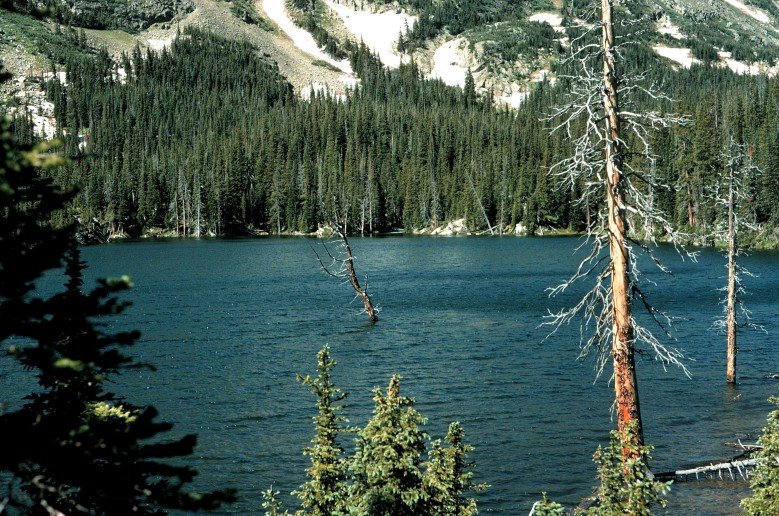forum
library
tutorial
contact

Producing Salmon: Study Looks at Cost Effectiveness
of Habitat Restoration Compared to Hatcheries
by Staff
Columbia Basin Bulletin, April 3, 2016
|
the film forum library tutorial contact |

|
Producing Salmon: Study Looks at Cost Effectiveness
by Staff
|
 The average cost to produce a juvenile coho salmon through habitat restoration in British Columbia is about the same cost as producing a hatchery salmon, according to a recent study.
The average cost to produce a juvenile coho salmon through habitat restoration in British Columbia is about the same cost as producing a hatchery salmon, according to a recent study.
The study looked at the effectiveness of restoring habitat and increasing smolt production, along with the costs of the projects, in a string of off-channel improvements in the upper Chilliwack River in British Columbia and Washington State.
About $14 billion to $15 billion has been spent since 1990 on freshwater habitat restoration projects in the United States alone, but this is one of the few studies that has considered the cost-effectiveness of such projects.
It found that the cost of producing one additional coho smolt with habitat restoration, amortized over 30 years, is $0.69 to $10.05, whereas the cost for a hatchery to produce a smolt is typically about $1.00.
"While the effectiveness of restoration was not entirely surprising, it came as something of a surprise that cost of production per smolt from some of the restored habitats was comparable to hatchery production costs per smolt," said corresponding author Jordan Rosenfeld, stream ecosystem scientist, BC Ministry of Environment.
Restoration project costs included thirty years of maintenance to ensure the projects remain viable, so both restoration project costs and hatchery costs are amortized over thirty years. The cost per smolt is the result of that calculation.
The study, "Watershed-scale effectiveness of floodplain habitat restoration for juvenile coho salmon in the Chilliwack River, British Columbia," was published online in the Canadian Journal of Fisheries and Aquatic Sciences.
In addition to Rosenfeld, authors are Lindsey Ogsten, Master of Science Student at the University of Toronto; Sam Gidora, restoration biologists with Fisheries and Oceans Canada; and Matt Foy, senior biologist, also with Fisheries and Oceans Canada.
With costs being equal, the study concludes that wild juveniles from restored habitat "arguably have higher value than hatchery-reared fishes, because they survive better in the wild and have higher reproductive success." The newly restored habitats also offer shelter and rearing habitat for other species in the Chilliwack River, including steelhead, bull trout and pink salmon, the study says.
According to Rosenfeld, the study was developed as a "rigorous effectiveness evaluation of the typical side-channel/off-channel restoration activities that were taking place in coastal rivers under the BC Watershed Restoration Program." That program was established to mitigate the damage to streams caused by logging, particularly loss or isolation of floodplain habitat.
The study concludes that off-channel restoration projects to increase rearing and spawning habitat are not only effective at increasing local abundance of wild juvenile coho and other salmonids, but effectively increased production of coho smolts at a watershed-scale, Rosenfeld added.
The study evaluated the increase in abundance of juvenile coho salmon resulting from a series of off-channel projects designed specifically for coho spawning, rearing and overwintering, finding that the projects increased coho production 27 percent to 34 percent.
Even in the most conservative case where all side-channel smolts are recruited from mainstem river habitat, the added survival of smolts overwintering in the new side channel would be 40 percent, still resulting in an overall increase in smolt production of 13.4 percent, according to the study.
"This indicates that the cumulative additive effects of individual restoration projects can result in population level impacts at larger scales," Rosenfeld said.
Of the restoration projects, the study found that those with a higher percentage of spawning habitat tended to be more expensive per smolt. That indicates that projects primarily for rearing and overwintering are the most cost-effective for coho smolt production.
The study also found that a restoration project that includes overwintering habitat will provide production benefits for both large and small populations of adult returning fish.
Most projects should include an evaluation component even though it is more tempting to spend as much money as possible on the habitat improvement, the study says, rather than adding in the cost of an evaluation.
"Evaluating the effectiveness of strategically selected restoration projects is essential for demonstrating their value, and for refining restoration approaches to optimize production," Rosenfeld said. "Some level of project monitoring is usually essential, but needs to be strategic."
For example, monitoring of the physical functioning of a restoration project is usually a given, but more intensive biological monitoring should be targeted to the subset of restoration applications where it will be most informative, Rosenfeld added.
He also said that some level of ongoing maintenance is important and is a relatively small cost for most projects. It is important to maintain fish access to constructed habitat, since obstructions to inflows and outflows are common and can greatly reduce productive capacity.
learn more on topics covered in the film
see the video
read the script
learn the songs
discussion forum
